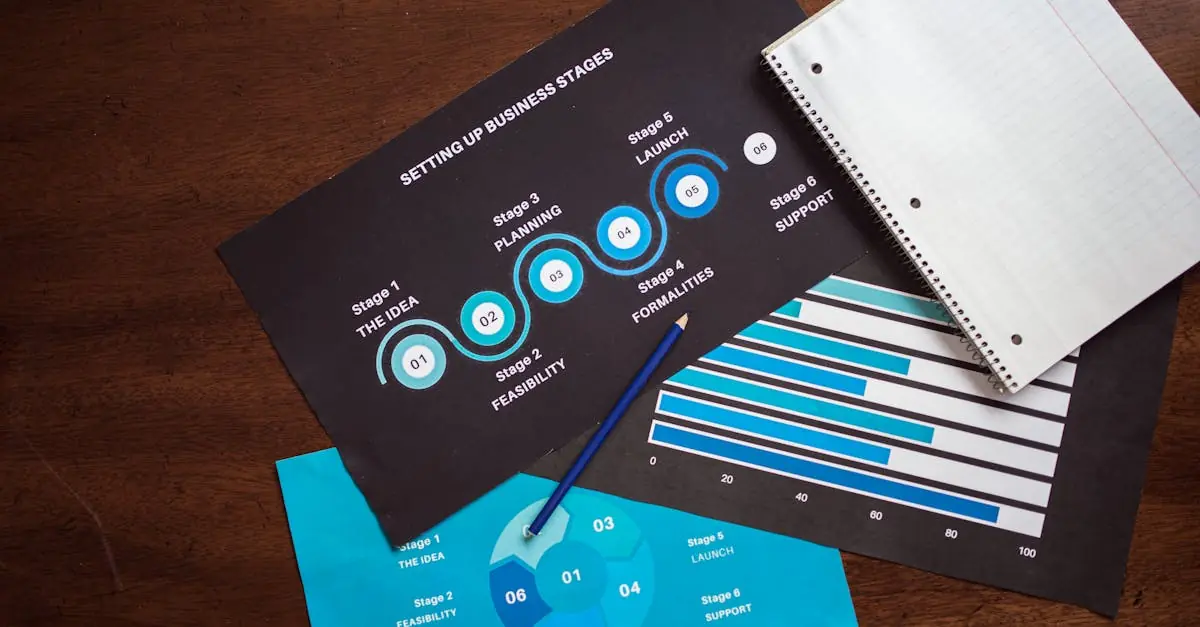Launching a product can feel like preparing for a first date—exciting yet nerve-wracking. One wrong move, and that promising romance could fizzle out faster than a soda left open overnight. The secret to a successful product launch lies in a well-crafted sequence, ensuring every step is as smooth as butter on warm toast.
Table of Contents
ToggleUnderstanding Product Launch Sequence
A product launch sequence requires careful planning and execution. Success often hinges on having a clear roadmap throughout the entire process.
Importance of a Well-Defined Sequence
A well-defined sequence establishes structure and clarity. This organization enables teams to track progress and adhere to timelines effectively. Additionally, it enhances communication across departments such as marketing, development, and sales. Each step of the launch, from market research to post-launch follow-up, holds significance and can influence overall outcomes. Teams that adopt a systematic approach might witness higher engagement rates and sales figures, ultimately driving value for the product and the organization.
Common Mistakes to Avoid
Rushing the preparation phase can lead to inadequate market research. Expecting swift success without proper testing often results in unforeseen issues. Overlooking customer feedback during development stages means missing critical insights that could enhance the product. Ignoring the importance of a post-launch analysis often hinders future improvements and growth opportunities. Teams should avoid focusing solely on marketing promotions; they must integrate customer experience into the launch strategy for broader impact.
Key Phases of Product Launch Sequence
A product launch sequence involves several critical phases that significantly impact its success. Each phase ensures the organization addresses every vital aspect of the launch.
Pre-Launch Preparation
Pre-launch preparation sets the foundation for a successful launch. Market research identifies target audiences and assesses competition, enabling teams to tailor strategies effectively. Developing a marketing strategy promotes awareness and engagement among potential customers. Creating promotional materials ensures that messaging aligns with brand values. Establishing clear timelines helps track progress and responsibilities across teams. Engaging with early adopters gathers valuable feedback, which can refine the final product. Prioritizing these steps maximizes the potential for a smooth launch.
Launch Day Activities
Launch day activities require meticulous execution for optimal impact. Coordinating a launch event generates buzz and engages audiences directly. Deploying marketing campaigns across various channels amplifies visibility and reach, capturing attention swiftly. Monitoring social media platforms for real-time interactions allows teams to respond to customer inquiries and capitalize on feedback. Tracking analytics provides immediate insights into campaign performance, guiding any necessary adjustments. Evaluating product performance during early hours enables teams to address any issues promptly, improving customer satisfaction.
Post-Launch Follow-Up
Post-launch follow-up remains crucial for long-term success. Gathering customer feedback reveals insights into user experience and satisfaction. Analyzing sales data highlights trends and identifies areas for improvement. Engaging with customers through surveys or interviews fosters a connection, showcasing commitment to their needs. Developing a plan for ongoing marketing efforts keeps momentum alive, encouraging further sales. Evaluating the overall launch process identifies lessons learned, informing future product iterations and strategies. Continuous improvement ensures sustained growth and adaptation in a dynamic market.
Best Practices for an Effective Product Launch Sequence
An effective product launch sequence combines meticulous planning with strategic execution. This phase focuses on engaging customers and tracking performance.
Customer Engagement Strategies
Building anticipation before the launch generates excitement among potential customers. Utilize social media polls or surveys to gauge interest and preferences. Offering exclusive sneak peeks to early adopters fosters loyalty and encourages valuable feedback. Hosting webinars or live Q&A sessions creates a two-way dialogue, enhancing customer relationships. Rewarding engagement with limited-time offers or discounts encourages participation and supports word-of-mouth marketing.
Performance Metrics to Track
Tracking key performance metrics provides insights into the launch’s effectiveness. Monitor website traffic and social media engagement to assess reach and resonance with the target audience. Sales figures during the launch period reveal immediate reception, while customer feedback captures sentiment and areas for improvement. Analyzing conversion rates helps identify the effectiveness of marketing strategies in driving purchases. Finally, tracking customer retention rates post-launch indicates long-term success and guides future product iterations.
Tools and Resources for Product Launch
A successful product launch relies on the right tools and resources. These facilitate each phase of the process, enhancing overall effectiveness.
Software Solutions
Numerous software solutions streamline various aspects of product launches. Project management tools like Trello and Asana help teams organize tasks, assign responsibilities, and track progress. Email marketing platforms such as Mailchimp and ConvertKit support promotional campaigns, ensuring timely communication with customers. Analytics tools like Google Analytics deliver insights into website traffic, user behavior, and conversions. Customer relationship management systems, including HubSpot, aid in managing customer interactions and insights throughout the lifecycle. Social media management tools, such as Hootsuite and Buffer, enable teams to plan and execute social media strategies efficiently.
Educational Materials
Access to educational materials optimizes the product launch experience. Comprehensive guides and case studies provide insights into successful strategies employed by others. Webinars and online courses on platforms like Udemy and Coursera enhance team skills in marketing, analytics, and customer engagement. Industry reports and whitepapers offer valuable data on market trends and consumer behavior. Networking events and conferences enable knowledge-sharing with industry peers, fostering connections and potential collaborations. Blogs and newsletters from industry leaders supply ongoing tips and updates relevant to product launching.
A successful product launch sequence is essential for achieving long-term growth and customer satisfaction. By prioritizing careful planning and strategic execution teams can navigate the complexities of launching a new product with confidence. Engaging customers throughout the process not only builds anticipation but also fosters loyalty and valuable feedback.
Utilizing the right tools and resources streamlines the launch experience and enhances communication across departments. Continuous analysis of performance metrics post-launch ensures that teams can adapt and improve future strategies. With a well-defined sequence in place every step of the journey becomes an opportunity for learning and growth, ultimately paving the way for sustained success in an ever-evolving market.








